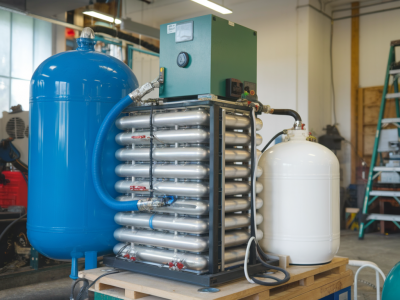
In recent years, solar energy has steadily proven its worth as one of the cornerstones of sustainable energy. From sprawling rooftop solar panels to massive solar farms, it’s incredible to witness how far this technology has come. But have you ever thought about the untapped potential of windows as energy generators? Thanks to the advent of solar windows, this possibility is no longer science fiction but an emerging reality. Imagine buildings that don’t just house people or businesses but actively produce clean energy. It’s an exciting time to explore how solar windows are reshaping our relationship with architecture and energy production altogether.
What Are Solar Windows?
The concept of solar windows revolves around integrating photovoltaic technology into window materials, essentially transforming transparent surfaces into energy-producing components. Unlike traditional solar panels, which are bulky and opaque, solar windows seamlessly blend into a building's architecture, offering dual functionality: harvesting solar energy and serving as ordinary windows.
Leading technologies in this space include transparent photovoltaic (TPV) systems and solar coatings. These innovations allow sunlight to pass through while capturing specific wavelengths of light to generate electricity. Companies such as Ubiquitous Energy and SolarWindow Technologies are pioneering advancements in this field, pushing the boundaries of what’s possible.
How Do Solar Windows Work?
To understand how solar windows work, let’s break it down:
- Transparent Solar Cells: These cells are engineered to absorb ultraviolet (UV) and infrared (IR) light rather than visible light, making them appear almost entirely transparent to the human eye.
- Solar Coatings: Another approach involves applying a thin layer of solar material to existing windows. These coatings collect energy without obstructing your view.
- Energy Conversion: The absorbed UV and IR light is converted into electricity, which is then either stored in a battery or fed directly into the building’s electrical system.
The beauty of this technology lies in its adaptability. Whether incorporated during a building’s construction or retrofitted onto an existing structure, solar windows offer highly versatile applications.
What Are the Benefits of Solar Windows?
Solar windows represent a game-changing innovation for several reasons:
- Dual Purpose: They eliminate the trade-off between function and aesthetics. Buildings no longer need to sacrifice design to incorporate energy-efficient technology.
- Energy Efficiency in Urban Areas: Solar windows are particularly beneficial in dense urban settings where rooftop space is limited. Skyscrapers, for example, could generate significant amounts of renewable energy by outfitting their vast glass surfaces.
- Reduction in Carbon Footprint: By using solar windows, buildings can substantially lower their reliance on grid electricity, decreasing their carbon footprint and boosting overall sustainability.
- Cost Savings: Beyond the upfront investment, solar windows reduce energy costs in the long term by generating a portion of the building's electricity needs.
- Lightweight and Easy Installation: Unlike traditional solar panels, solar windows require no additional structural support, making them easier and faster to install.
Potential Applications for Solar Windows
The versatility of solar windows opens up many exciting possibilities across all types of environments and industries. Here are a few worth mentioning:
- Residential Buildings: Homeowners can install solar windows to not only power their homes sustainably but also add an extra layer of innovation and market value to their properties.
- Commercial Real Estate: Large-scale office buildings, shopping malls, and hospitals can generate energy while maintaining their visual appeal. Plus, integrating solar windows into new designs helps businesses meet green building certifications.
- Public Infrastructure: Solar windows have the potential to revolutionize public spaces like train stations, airports, and bus terminals, where ample glass surfaces are already in use.
- Electric Vehicles (EVs): As EVs continue to rise in popularity, some manufacturers are exploring the idea of integrating solar window technology into cars, enabling vehicles to partially recharge themselves. Imagine driving with windows that convert sunlight directly into battery power!
Challenges and Limitations
While the promise of solar windows is undeniable, the technology still faces some hurdles that need to be addressed for widespread adoption:
- Efficiency: Solar windows currently lag behind traditional solar panels in terms of efficiency. However, rapid advancements in materials science and engineering suggest this gap could close in the coming years.
- High Costs: As with most cutting-edge technologies, solar windows are still relatively expensive compared to conventional options. Wider adoption and production scale-ups are expected to drive down costs.
- Durability: Solar windows must match or exceed the longevity and resilience of regular windows while maintaining their energy-harvesting capabilities.
Despite these challenges, I remain optimistic about the potential for solar windows to achieve mainstream success. Just as we’ve seen with rooftop solar, costs tend to decrease and efficiency improves as adoption grows.
Current Innovations and What’s Next?
The solar window industry is mushrooming with innovation. One standout company, Ubiquitous Energy, has developed highly transparent solar glass that’s being tested in residential and commercial markets. SolarWindow Technologies, meanwhile, has created a liquid coating that can be applied to existing windows, reducing the need for costly replacements.
Looking ahead, the integration of solar windows with smart technology will further amplify their impact. Imagine a scenario where buildings equipped with solar windows intelligently adjust their transparency levels to maximize energy production or reduce the need for air conditioning on hot days.
Moreover, as governments around the world continue to strengthen renewable energy incentives and pass stricter environmental regulations, solar windows could soon become an essential feature of new building designs and retrofits alike.
Ultimately, solar windows symbolize a shift toward a future where energy generation is no longer confined to solar farms or rooftop panels. Instead, it will be woven seamlessly into our everyday built environment—turning windows into silent, invisible power generators that contribute to our collective sustainability goals.
